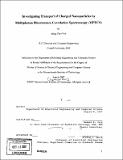Investigating transport of charged nanoparticles by multiphoton fluorescence correlation spectroscopy (MPFCS)
Author(s)
Poh, Ming-Zher
DownloadFull printable version (9.935Mb)
Other Contributors
Massachusetts Institute of Technology. Dept. of Electrical Engineering and Computer Science.
Advisor
Rakesh K. Jain.
Terms of use
Metadata
Show full item recordAbstract
Nanoparticles have been demonstrated as a promising new generation of specific imaging agents and targeted delivery vehicles for the diagnosis and treatment of solid tumors. Nonetheless, for optimal therapy of tumors, the nanoparticles must penetrate the tumor interstitial matrix to reach the cancer cells. This thesis describes the development of a multiphoton fluorescence correlation spectroscopy (MPFCS) system and its utilization to probe the effect of charge on the diffusion of quantum dot (QD) nanocrystals in collagen and collagen-hyaluronan (HA) composite gel models of human colon adenocarcinoma (LS174T). The MPFCS system was integrated with a multiphoton laser-scanning microscope (MPLSM) to enable visualization of QD distribution and collagen organization, as well as diffusion measurements. QDs of three different charges by modifying the surface of pre-made CdSe/CdZnS QDs with dihydrolipoic acid (DHLA), DHLA-polyethyleneglycol (DHLA-PEG) and amino-functionalized DHLA-PEG (DHLA-PEG-NH2). Aggregation was observed in QD-DHLA (4-potential = -31.12 mV) and QD-DHLA-PEG-NH2 (4-potential = +37.39 mV) samples in gels, but the distribution of QD-DHLA-PEG (ý-potential = -18.16 mV) was uniform. FCS measurements were performed for each QD sample in both gel models. Experimental data indicated anomalous subdiffusion of QDs in both gels with all samples having the same time exponent. The transport coefficient of QD-DHLA-PEG was significantly higher than QD-DHLA and QD-DHLA-PEG-NH2. A two-component free diffusion model also provided a good fit for the data, but did not provide a clear picture on the role of charge in diffusion. Our experiments suggest that anionic and cationic nanoparticles experience more hindrance compared to neutral, PEGylated nanoparticles in both collagen and collagen-HA gels.
Description
Thesis (S.M.)--Massachusetts Institute of Technology, Dept. of Electrical Engineering and Computer Science, 2007. Includes bibliographical references (leaves 82-85).
Date issued
2007Department
Massachusetts Institute of Technology. Department of Electrical Engineering and Computer SciencePublisher
Massachusetts Institute of Technology
Keywords
Electrical Engineering and Computer Science.